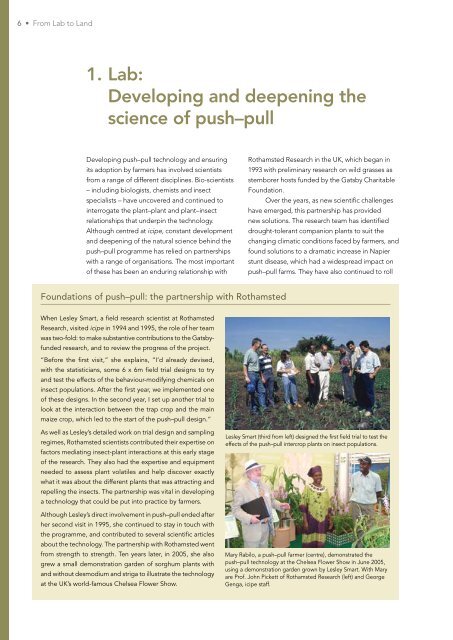to Land
women_in_push-pull
women_in_push-pull
Create successful ePaper yourself
Turn your PDF publications into a flip-book with our unique Google optimized e-Paper software.
6 • From Lab <strong>to</strong> <strong>Land</strong><br />
1. Lab:<br />
Developing and deepening the<br />
science of push–pull<br />
Developing push–pull technology and ensuring<br />
its adoption by farmers has involved scientists<br />
from a range of different disciplines. Bio-scientists<br />
– including biologists, chemists and insect<br />
specialists – have uncovered and continued <strong>to</strong><br />
interrogate the plant–plant and plant–insect<br />
relationships that underpin the technology.<br />
Although centred at icipe, constant development<br />
and deepening of the natural science behind the<br />
push–pull programme has relied on partnerships<br />
with a range of organisations. The most important<br />
of these has been an enduring relationship with<br />
Rothamsted Research in the UK, which began in<br />
1993 with preliminary research on wild grasses as<br />
stemborer hosts funded by the Gatsby Charitable<br />
Foundation.<br />
Over the years, as new scientific challenges<br />
have emerged, this partnership has provided<br />
new solutions. The research team has identified<br />
drought-<strong>to</strong>lerant companion plants <strong>to</strong> suit the<br />
changing climatic conditions faced by farmers, and<br />
found solutions <strong>to</strong> a dramatic increase in Napier<br />
stunt disease, which had a widespread impact on<br />
push–pull farms. They have also continued <strong>to</strong> roll<br />
Foundations of push–pull: the partnership with Rothamsted<br />
When Lesley Smart, a field research scientist at Rothamsted<br />
Research, visited icipe in 1994 and 1995, the role of her team<br />
was two-fold: <strong>to</strong> make substantive contributions <strong>to</strong> the Gatsbyfunded<br />
research, and <strong>to</strong> review the progress of the project.<br />
“Before the first visit,” she explains, “I’d already devised,<br />
with the statisticians, some 6 x 6m field trial designs <strong>to</strong> try<br />
and test the effects of the behaviour-modifying chemicals on<br />
insect populations. After the first year, we implemented one<br />
of these designs. In the second year, I set up another trial <strong>to</strong><br />
look at the interaction between the trap crop and the main<br />
maize crop, which led <strong>to</strong> the start of the push–pull design.”<br />
As well as Lesley’s detailed work on trial design and sampling<br />
regimes, Rothamsted scientists contributed their expertise on<br />
fac<strong>to</strong>rs mediating insect-plant interactions at this early stage<br />
of the research. They also had the expertise and equipment<br />
needed <strong>to</strong> assess plant volatiles and help discover exactly<br />
what it was about the different plants that was attracting and<br />
repelling the insects. The partnership was vital in developing<br />
a technology that could be put in<strong>to</strong> practice by farmers.<br />
Although Lesley’s direct involvement in push–pull ended after<br />
her second visit in 1995, she continued <strong>to</strong> stay in <strong>to</strong>uch with<br />
the programme, and contributed <strong>to</strong> several scientific articles<br />
about the technology. The partnership with Rothamsted went<br />
from strength <strong>to</strong> strength. Ten years later, in 2005, she also<br />
grew a small demonstration garden of sorghum plants with<br />
and without desmodium and striga <strong>to</strong> illustrate the technology<br />
at the UK’s world-famous Chelsea Flower Show.<br />
Lesley Smart (third from left) designed the first field trial <strong>to</strong> test the<br />
effects of the push–pull intercrop plants on insect populations.<br />
Mary Rabilo, a push–pull farmer (centre), demonstrated the<br />
push–pull technology at the Chelsea Flower Show in June 2005,<br />
using a demonstration garden grown by Lesley Smart. With Mary<br />
are Prof. John Pickett of Rothamsted Research (left) and George<br />
Genga, icipe staff.


